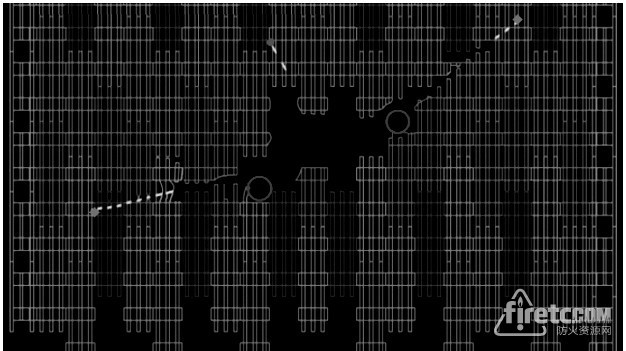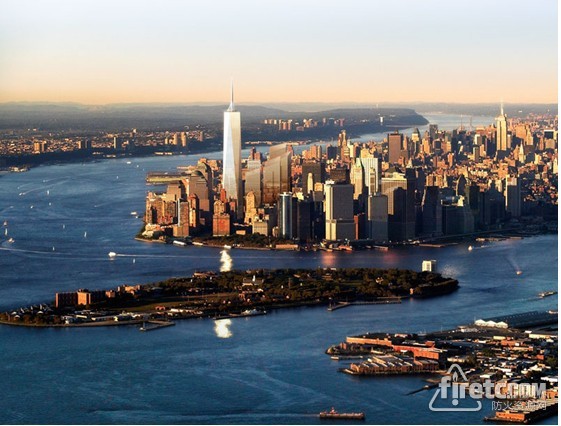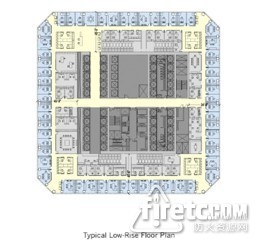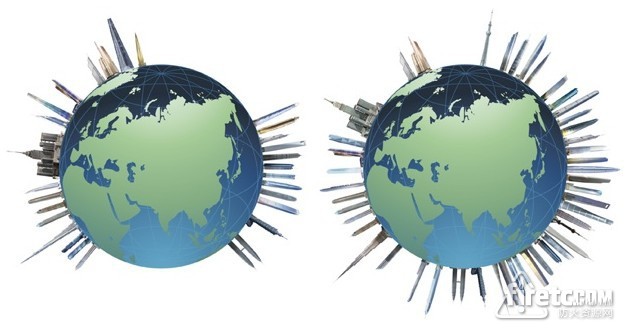
A graphic of a 9/11 plane-crash hole in one of the
Ten years after that tragic event, sun finds its way among the shadows. Light pours onto freshly hardened concrete, just-hung sheets of glass, and newly erected steel beams as construction progresses toward the completion of all 1,776 feet of a newer, taller tower at
The reborn site is where a skyscraper sometimes referred to as the “

A rendering of
Above all, though, the massive civic project indicates that the next chapter in international skyscraper design has begun. As a new urban silhouette emerges in
“After 9/11, asking whether the skyscraper was ‘over’ was a legitimate proposition, as it was clear that high-rises were terrorist targets,” said Cathleen McGuigan, editor-in-chief of the trade publication Architectural Record. “In fact, the opposite happened.”
In some ways, though, the pre-9/11 notion of what a skyscraper should be is over, as the new tall buildings that are on the rise are designed to be higher, stronger, safer, and smarter than those of the
Since the 9/11 attacks, architects who specialize in designing high-rises for major cities have worked to conquer design challenges that simply did not exist before 2001. Unprecedented security concerns and new safety regulations and codes — not to mention lingering terrorist fear in the minds of occupants — have required a new approach to tall structures in the post-9/11 age.
LEARNING FROM DISASTER
Many fundamental changes to skyscraper design were the direct result of regulation enacted in the wake of the destruction of 1 and 2
Research conducted by the U.S. National Institute of Standards and Technology on the collapse of the
Among them: increased structural integrity through alternate load-bearing paths, fire resistance by design (”burnout without collapse”), better building evacuation routes and redundant systems for sprinklers, hoses, fire alarms and smoke management.
“Had the building been significantly more than one-third to one-half occupied, the casualties would likely have been far higher,” the NIST report authors write of 1 WTC’s design. “The exiting population would have exceeded the capacity of the stairwells to evacuate them in the time available.”
Many of the NIST’s recommendations have been adopted, with others planned soon. In 2009, the International Code Council added 23 code changes to the International Building Code and the International Fire Code based on the NIST’s report on the
Last year, the ICC approved 17 additional code changes based on the NIST’s investigation, including the improvement of emergency radio communications for first responders and elevator safety. The changes will be included in the 2012 International Building Code and International Fire Code.

A floorplan of
Many of these concerns are addressed in the design for the new tower at
Skidmore, Owings & Merrill, the building’s architects, say they have exceeded the NIST’s recommendations and
DESIGN, DECODED
One way that architects at SOM and other firms are meeting new building codes that surfaced after the destruction of the original World Trade Center towers is through a borrowed-innovation approach, in which multi-national firms take their most inventive responses to strict safety and security regulations and import them into nations where regulations are less demanding, including the U.S. The approach can reduce the time needed for original research and development.
“Some architects have been translating from developing European safety standards and building codes in other parts of the world,” said Carl Galioto, managing principal at HOK and a contributor to the 2003 book Building Security: Handbook for Architectural Planning and Design.
“For instance, in
Protections around the entire perimeters of building sites and extra space for security-screening areas and turnstiles that record entries and exits are also much more prevalent in new construction since 9/11, he said.
The architects of SOM say they mined their extensive global portfolio for the design of the new
“We looked at our designs for foreign embassies and courthouses and brought that knowledge to bear on the new
The firm designed the concrete core to encase all of the building’s safety systems, including the tower’s
communication antennae (to help ensure communication with first responders in a disaster), as well as exhaust and ventilation shafts and elevators.
For one of the most symbolic and highly anticipated skyscrapers in architectural history, the approach helps to guarantee SOM a design strategy that is both tested and efficient.
“These [building details] sound like subtleties, but they all come together in the design to provide a class A office space in the most demanding market in the world and meet the security and safety requirements this location demands,” Lewis said.
So far, the strategy is working. Earlier this year, publisher Conde Nast (Vogue, The New Yorker, Vanity Fair, Glamour) signed a $2 billion, 25-year lease to be an anchor tenant when the building opens in 2014–leaving behind a glassy high-rise at 4 Times Square, a prestigious address in Manhattan’s Midtown business district.
SUPERTALL STRUCTURES & ‘HIGH PERFORMANCE DESIGN’
In the immediate aftermath of 9/11, it may have seemed possible for security concerns to outweigh the cultural role that skyscrapers play as trophies of industry and milestones of human engineering. But today, supertall structures – defined by
The new
Despite an international economic downturn, there are now 48 supertall structures that make the cut, according to this year’s Global Supertall Survey. Each new addition carries more safety and energy-efficient features than its predecessor, and top American architectural firms such as SOM, Kohn Pedersen Fox Associates, and Gensler are designing skyscrapers in Asia and the

A comparison of the number of supertall buildings in 2007 (left) vs. in 2011 (right)
“The most difficult aspect of designing any significant building post-9/11 is three simple words: high performance design,” Lewis said. “High performance design is what drives our high-rise practice; energy efficiency, indoor quality/comfort, space efficiency/usability, safety and security are all about performance.”
“Security is of the highest concern, a concern that must be balanced with making a place that people want to be in, live in and work in,” he said. “Otherwise there is nothing worth securing or protecting from acts of God or man.”
REVOLUTION, OR EVOLUTION?
Did the Sept. 11 attacks really spark changes in skyscraper design across the globe, or did the event merely serve to mark a new chapter in an ongoing evolution?
“When we think of how world changed after 9/11, safety and security are the principle factors we think about,” Willis said. “But there are other types of security that architects and structural engineers are designing for as well today. Yes, they are addressing building security against terrorism…but around the world, you will see new designs and structural engineering for security against loss prevention and security against damage from earthquakes and from wind.”
In reality, little has changed in places with healthy high-rise markets, such as
“One premise that people in the
There remains a ripple effect, however. Some new Asian skyscrapers were designed with security features that reflect post-9/11 concerns. For example, the 1,614-ft.-tall
OPTIMISTIC SYMBOLS
Whether terrorist target or industrial icon, the skyscraper continues to serve as the vehicle for cutting-edge technology, daring design, and inventive engineering. A decade after the Sept. 11 terrorist attacks that destroyed two prominent high-rises and thousands of lives, it’s clear that architects and engineers are working fastidiously and creatively to ensure that the newest generation of supertall structures can reach higher than ever without sacrificing safety and efficiency.
In doing so, they continue to build on the century-old concept of the skyscraper as the world’s most visible and practical symbol of optimism, community and technical achievement.
“The skyscraper is an American invention,” Architectural Record’s McGuigan said. “It has always been about the outward edge of building technologies since the 19th century, when the safety elevator was invented, and higher buildings became possible. It’s important to have this historical context.”
“Skyscrapers have always been about expressing humankind’s desire to push forward. To make progress.”


